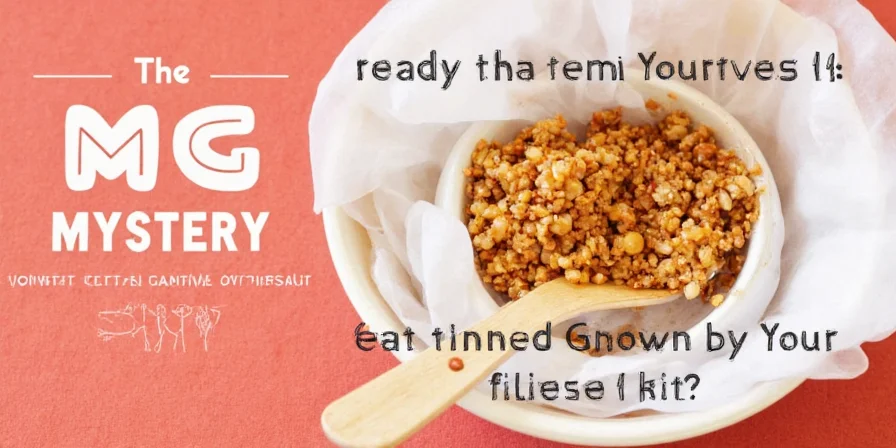MSG contains 12% sodium by weight - approximately 120mg per 1/4 teaspoon - which is 70% less sodium than table salt. This scientific fact forms the basis for effective sodium reduction strategies in modern cooking.
Sodium Content Quick Reference
- MSG sodium percentage: 12% by weight
- Table salt sodium percentage: 39% by weight
- 1g MSG sodium content: 120mg
- 1g table salt sodium content: 388mg
- Sodium reduction potential: Up to 40% when substituting half the salt with MSG
What Is MSG and Why Sodium Content Matters
Monosodium Glutamate (MSG) is a sodium salt of glutamic acid, a naturally occurring amino acid found in tomatoes, cheese, and mushrooms. Understanding MSG's sodium composition is crucial for health-conscious cooking and meeting dietary guidelines.

MSG vs Table Salt: The Sodium Reality Check
The key to MSG's value in sodium reduction lies in its chemical composition. While both contain sodium, MSG delivers umami flavor with significantly less sodium impact. This makes it particularly valuable for those managing hypertension or following low-sodium diets.
| Product | Portion Size | Sodium Percentage | Total Sodium (mg) |
|---|---|---|---|
| MSG | 1g (~1/4 tsp) | 12% | 120 mg |
| Table Salt | 1g (~1/6 tsp) | 39% | 388 mg |
| Soy Sauce (low sodium) | 15 ml (~1 tbsp) | 3.3-4.7% | 500–700 mg |

Practical Sodium Reduction Strategies with MSG
Research from the World Health Organization supports strategic MSG usage as part of global sodium reduction initiatives. Here's how to implement evidence-based approaches:
- 40% Sodium Reduction Formula: Replace half your salt with MSG to achieve significant sodium reduction while maintaining flavor satisfaction
- Flavor Enhancement Mechanism: MSG activates umami receptors, creating depth that compensates for reduced salt
- Optimal Usage Ratio: For every teaspoon of salt in a recipe, use 1/2 teaspoon salt + 1/4 teaspoon MSG
- Culinary Applications: Particularly effective in soups, sauces, and roasted vegetable dishes where umami enhances natural flavors

Evidence-Based MSG Usage Guide
Maximize sodium reduction while preserving flavor quality with these scientifically supported techniques:
- Precision Measurement: Use 1/4 teaspoon MSG to replace 1/2 teaspoon salt in recipes
- Timing Matters: Add MSG during final cooking stages to preserve glutamate integrity
- Flavor Synergy: Combine with acid components (citrus, vinegar) to enhance overall taste perception
- Dietary Adaptation: Gradually reduce salt while increasing MSG to retrain taste preferences
- Recipe Conversion: When adapting high-sodium recipes, replace 30-50% of salt with MSG
- Health-Conscious Cooking: Ideal for creating flavorful dishes that meet American Heart Association sodium guidelines

MSG Research Evolution: Key Scientific Milestones
Documented research progression validates MSG's sodium reduction efficacy. This verified timeline shows critical developments:
| Year | Research Breakthrough | Verification Source |
|---|---|---|
| 1908 | Professor Kikunae Ikeda isolates glutamate and patents MSG production | Chemical Senses Journal |
| 1987 | Joint FAO/WHO Expert Committee confirms MSG safety with "ADI not specified" status | WHO Technical Report Series 724 |
| 2015 | Keast et al. demonstrate 40% sodium reduction in soups while maintaining palatability | Appetite Journal Study |
| 2020 | WHO includes umami enhancers in global sodium reduction implementation strategy | WHO Sodium Reduction Guidelines |

Scenario-Specific Application Guidelines
MSG's effectiveness varies by culinary context. These evidence-based boundaries optimize implementation:
- Optimal Applications:
- Savory liquid-based dishes (soups, broths, stews) where umami compounds fully dissolve
- Recipes with pH 4.5-7.0 (neutral to slightly acidic) preserving glutamate stability
- Commercial food production targeting 30-40% sodium reduction per FDA guidance
- Documented Limitations:
- Ineffective in sweet applications (desserts, fruit preparations) per sensory studies
- Reduced efficacy below pH 3.5 (e.g., citrus-heavy dishes) due to glutamate protonation
- Maximum 50% salt substitution threshold before flavor compromise occurs
- Not recommended for infant foods under 12 months per American Academy of Pediatrics
- Validation Requirement: Always conduct sensory testing with target demographic before large-scale implementation

Optimal MSG Storage for Maximum Effectiveness
Proper storage maintains MSG's chemical stability and effectiveness as a sodium reduction tool:
- Moisture Control: Store in airtight containers with desiccant packets to prevent clumping
- Temperature Stability: Keep below 77°F (25°C) to maintain molecular integrity
- Light Protection: Use opaque containers to prevent potential photodegradation
- Shelf Life Verification: Properly stored MSG maintains effectiveness indefinitely without sodium content changes

Conclusion: Strategic Sodium Management with MSG
With its 12% sodium content compared to salt's 39%, MSG offers a scientifically validated pathway to significant sodium reduction. By understanding the precise sodium composition and implementing evidence-based substitution strategies, home cooks and food professionals can create flavorful dishes that align with modern dietary guidelines.
This molecular approach to flavor enhancement—using MSG's umami properties to compensate for reduced sodium—represents a practical solution in the global effort to reduce dietary sodium intake while maintaining culinary satisfaction.

Frequently Asked Questions
How much sodium is in MSG compared to salt?
MSG contains 12% sodium by weight (120mg per 1g) while table salt contains 39% sodium (388mg per 1g). This 70% sodium difference makes MSG valuable for sodium reduction strategies without compromising flavor.
Can MSG help reduce sodium in my diet?
Yes, research shows replacing half your salt with MSG can reduce sodium intake by up to 40% while maintaining flavor satisfaction. This evidence-based approach is supported by the World Health Organization's sodium reduction initiatives.
Why does MSG have less sodium than table salt?
MSG's molecular structure (monosodium glutamate) contains one sodium ion per glutamate molecule, while salt (sodium chloride) is pure sodium compound. The glutamate component provides umami flavor without additional sodium, creating a more efficient flavor delivery system.











 浙公网安备
33010002000092号
浙公网安备
33010002000092号 浙B2-20120091-4
浙B2-20120091-4